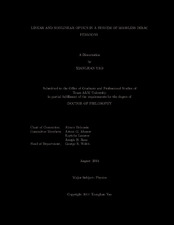| dc.description.abstract | Graphene electrons possess linear energy dispersion relation, and thus behave as two-dimensional (2D) Dirac fermions. Consequently, compared with the conventional 2D electron gas systems (2DEG) found in MOSFETs and quantum wells, graphene exhibits a variety of electronic and optoelectronic properties that are characteristic of 2D Dirac fermions. Similar 2D Dirac fermions are found at the surface layer of 3D topological insulator, and they are topological protected from backscattering due to spin-orbital coupling and time reversal symmetry.
We here calculate the linear and nonlinear optical response of graphene in strong magnetic and optical fields, using a quantum-mechanical density-matrix formalism. We show that graphene in a magnetic field possesses a giant mid- or far-infrared optical nonlinearity, perhaps the highest among known materials. The high nonlinearity originates from the unique electronic properties and selection rules near the Dirac point. As a result, even one monolayer of graphene gives rise to an appreciable nonlinear frequency conversion efficiency for incident infrared radiation.
Inspired by the highly efficient four-wave mixing process in the 2D Dirac fermion systems, we further propose a new mechanism of generating polarization-entangled photons based on the parametric generation process in the third section of this dissertation. Unique properties of quantized electron states in a magnetized graphene and optical selection rules near the Dirac point give rise to a giant optical nonlinearity and a high rate of photon production in the mid- or far-infrared range. A similar mechanism of photon entanglement may exist in topological insulators where the surface states have a Dirac-cone dispersion and demonstrate similar properties of magneto-optical absorption.
In the absence of a magnetic field, the surface plasmon resonance provides an alternative method to enhance nonlinear frequency conversion efficiency. In the forth section of this dissertation, a graphene-based difference frequency generation (DFG) of terahertz plasmons is proposed as an example to study nonlinear photonplasmon interaction in 2D Dirac fermion systems. Our results demonstrate strong enhancement of the DFG efficiency near the plasmon resonance and the feasibility of phase-matched nonlinear generation of plasmons over a broad range of frequencies. Considering graphene plasmonics' superiorities in wave confinement, dissipation and tunability, a graphene-based nonlinear terahertz plasmon generation process promises applications in terahertz sources and sensors, as well as integrated photonic circuits. | en |


